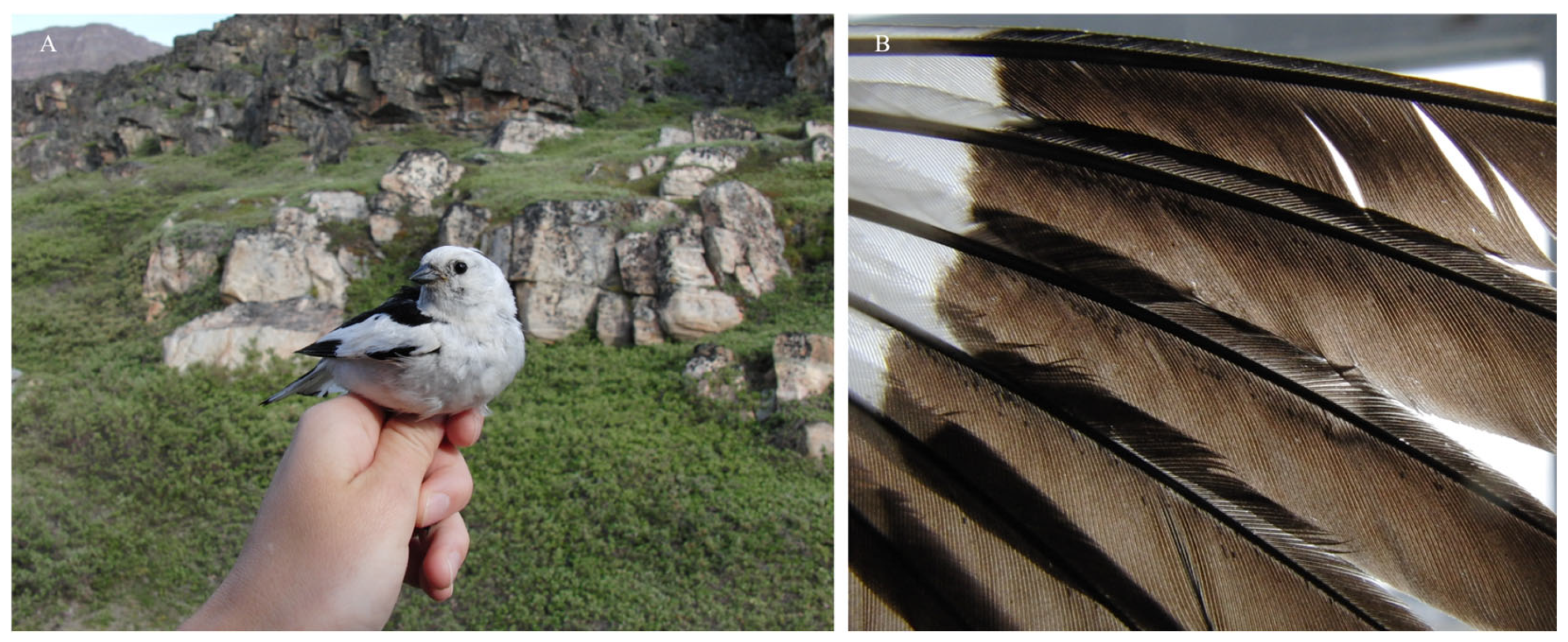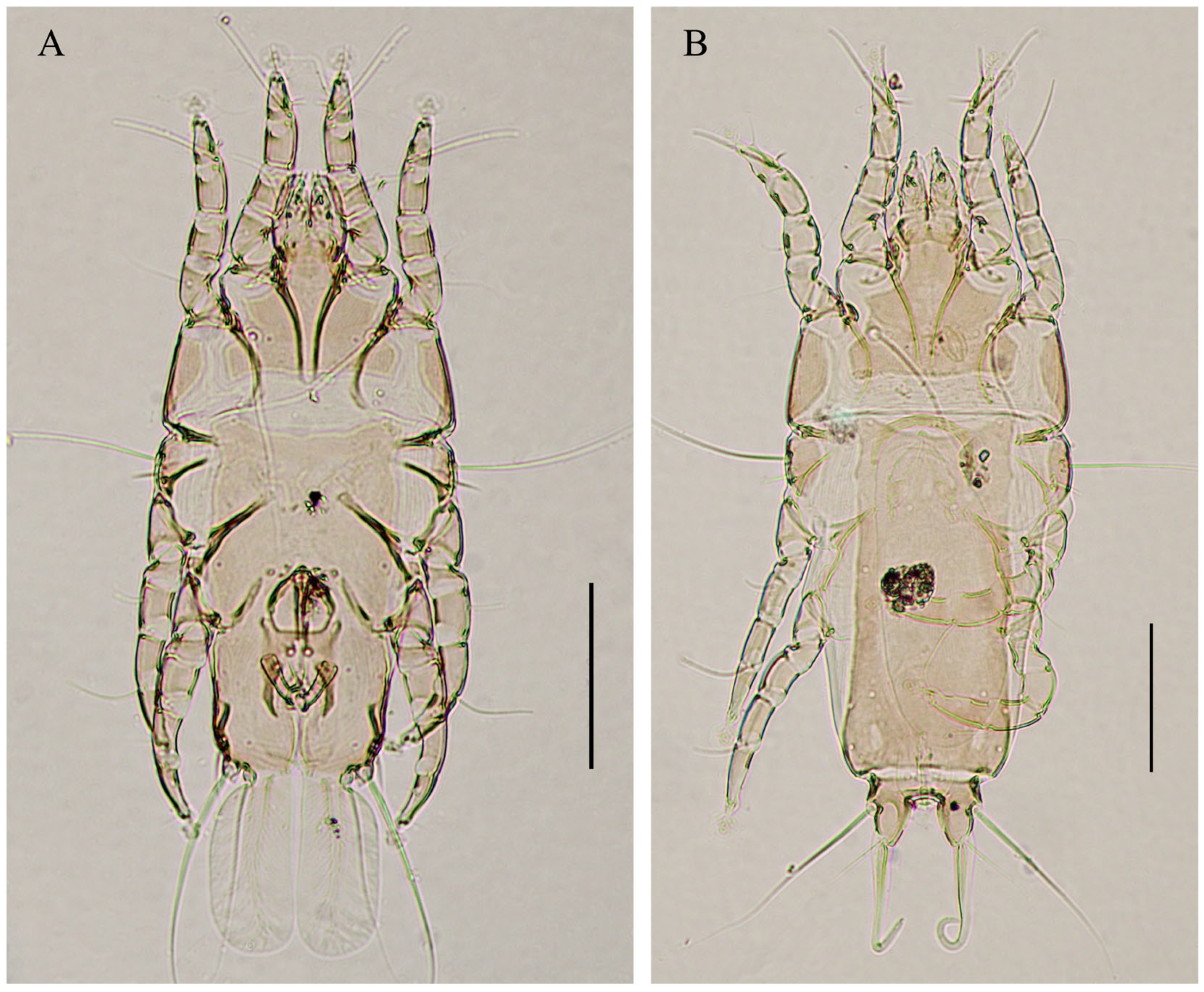New Records of Feather Mites (Acariformes: Analgoidea) on Passerines (Aves: Passeriformes) from Greenland
Simple Summary
Abstract
1. Introduction
2. Materials and Methods
3. Results and Discussion
4. Conclusions
Author Contributions
Funding
Institutional Review Board Statement
Data Availability Statement
Acknowledgments
Conflicts of Interest
References
- Dabert, J.; Mironov, S.V. Origin and evolution of feather mites (Astigmata). Exp. Appl. Acarol. 1999, 23, 437–454. [Google Scholar] [CrossRef]
- Proctor, H.C. Feather mites (Acari: Astigmata): Ecology, behavior and evolution. Annu. Rev. Entomol. 2003, 48, 185–209. [Google Scholar] [CrossRef] [PubMed]
- Doña, J.; Proctor, H.; Serrano, D.; Johnson, K.P.; Oploo, A.O.; Huguet-Tapia, J.C.; Ascunce, M.S.; Jovani, R. Feather mites play a role in cleaning host feathers: New insights from DNA metabarcoding and microscopy. Mol. Ecol. 2018, 28, 203–218. [Google Scholar] [CrossRef] [PubMed]
- Mironov, S.V. Morphological adaptations of feather mites to different types of plumage and skin of birds. Parazitol. Sb. 1987, 34, 114–132. (In Russian) [Google Scholar]
- Mironov, S.V. Feather mites: General morphological adaptations, phylogeny and coevolutionary relationships with birds. Ekologija 1999, 2, 57–65, (In English, with Russian summary). [Google Scholar]
- Blanco, G.; Tella, J.L.; Potti, J.; Baz, A. Feather mites on birds: Costs of parasitism or conditional outcomes? J. Avian Biol. 2001, 32, 271–274. [Google Scholar] [CrossRef]
- Galván, I.; Aguilera, E.; Atiénzar, F.; Barba, E.; Blanco, G.; Cantó, J.L.; Cortés, V.; Frías, Ó.; Kovács, I.; Meléndez, L.; et al. Feather mites (Acari: Astigmata) and body condition of their avian hosts: A large correlative study. J. Avian Biol. 2012, 43, 273–279. [Google Scholar] [CrossRef]
- Dubinin, V.B. Feather mites (Analgesoidea). Part 1. Introduction to their study. Fauna USSR 1951, 6, 1–363. (In Russian) [Google Scholar]
- Labrador, M.D.M.; Doña, J.; Serrano, D.; Jovani, R. Feather mites at night: An exploration of their feeding, reproduction, and spatial ecology. Ecology 2021, 103, e03550. [Google Scholar] [CrossRef] [PubMed]
- Gaud, J.; Atyeo, W.T. Feather mites of the world (Acarina, Astigmata): The supraspecific taxa. Ann. Mus. R. L’afrique Cent. Sci. Zool. 1996, 277 Pt 1–2, 193–436. [Google Scholar]
- Proctor, H.C.; Owens, I. Mites and birds: Diversity, parasitism and coevolution. Trends Ecol. Evol. 2000, 15, 358–364. [Google Scholar] [CrossRef] [PubMed]
- Stefan, L.M.; Gómez-Díaz, E.; Mironov, S.V.; González-Solís, J.; McCoy, K.D. “More than meets the eye”: Cryptic diversity and contrasting patterns of host-specificity in feather mites inhabiting seabirds. Front. Ecol. Evol. 2018, 6, 97. [Google Scholar] [CrossRef]
- Dubinin, W.B. Feather mites of birds of Wrangel Island. Tr. Zool. Inst. Akad. Nauk. SSSR 1952, 12, 251–268. (In Russian) [Google Scholar]
- Han, Y.-D.; Mironov, S.V.; Kim, J.-H.; Min, G.-S. Feather mites (Acariformes, Astigmata) from marine birds of the Barton Peninsula (King George Island, Antarctica), with descriptions of two new species. ZooKeys 2021, 1061, 109–130. [Google Scholar] [CrossRef] [PubMed]
- La Sorte, F.A.; Thompson III, F.R. Poleward shifts in winter ranges of North American birds. Ecology 2007, 88, 1803–1812. [Google Scholar] [CrossRef] [PubMed]
- Brommer, J.E.; Lehikoinen, A.; Valkama, J. The Breeding Ranges of Central European and Arctic Bird Species Move Poleward. PLoS ONE 2012, 7, e43648. [Google Scholar] [CrossRef] [PubMed]
- Koenigk, T.; Key, J.; Vihma, T. Climate Change in the Arctic. In Physics and Chemistry of the Arctic Atmosphere; Kokhanovsky, A., Tomasi, C., Eds.; Springer Polar Sciences; Springer: Cham, Switzerland, 2020. [Google Scholar] [CrossRef]
- D’Odorico, P.; He, Y.; Collins, S.L.; De Wekker, S.F.J.; Engel, V.; Fuentes, J.D. Vegetation–microclimate feedbacks in woodland–grassland ecotones. Glob. Ecol. Biogeogr. 2013, 22, 364–379. [Google Scholar] [CrossRef]
- Böcher, J.; Kristensen, N.P.; Pape, T.; Vilhelmsen, L. (Eds.) The Greenland Entomofauna: An Identification Manual of Insects, Spiders and Their Allies; Brill: Leiden, The Netherlands, 2015; Volume 44, p. 897. [Google Scholar] [CrossRef]
- Bennike, O. Colonisation of Greenland by plants and animals after the last ice age: A review. Polar Rec. 1999, 35, 323–336. [Google Scholar] [CrossRef]
- Lepage, D.A. Avibase—Bird Checklists of the World (Clements, Version 2024, Greenland). Available online: https://avibase.bsc-eoc.org/checklist.jsp?lang=EN (accessed on 27 May 2025).
- Boertmann, D. An annotated checklist to the birds of Greenland. Meddr. Greenl. Biosci. 1994, 38, 64. [Google Scholar] [CrossRef]
- Stone, W. Birds Collected by the West Greenland Expedition. Proc. Natl. Acad. Sci. USA 1892, 44, 145–152. [Google Scholar]
- Longstaff, T.G. An Ecological Reconnaissance in West Greenland. J. Anim. Ecol. 1932, 1, 119–142. [Google Scholar] [CrossRef]
- Hitch, A.T.; Leberg, P.L. Breeding distributions of North American bird species moving north as a result of climate change. Conserv. Biol. 2007, 21, 534–539. [Google Scholar] [CrossRef] [PubMed]
- Jiguet, F.; Devictor, V.; Ottvall, R.; van Turnhout, C.; van der Jeugd, H.; Lindström, Å. Bird population trends are linearly affected by climate change along species thermal ranges. Proc. R. Soc. Lond. B 2010, 277, 3601–3608. [Google Scholar] [CrossRef] [PubMed]
- Frimer, O. Densities and distribution of passerine hirds in a coastal area of Disko Island, West Greenland, with notes on breeding performance. Dan. Ornitol. Foren. Tidsskr. 1991, 85, 161–167. [Google Scholar]
- Callaghan, T.; Christensen, T.; Jantze, E. Plant and Vegetation Dynamics on Disko Island, West Greenland: Snapshots Separated by Over 40 Years. AMBIO 2011, 40, 624–637. [Google Scholar] [CrossRef] [PubMed]
- Stevenson, M.A.; McGowan, S.; Pearson, E.J.; Swann, G.E.A.; Leng, M.J.; Jones, V.J.; Bailey, J.J.; Huang, X.; Whiteford, E. Anthropocene climate warming enhances autochthonous carbon cycling in an upland Arctic Lake, Disko Island, West Greenland. Biogeosciences 2021, 18, 2465–2485. [Google Scholar] [CrossRef]
- Génsbøl, B. A Nature and Wildlife Guide to Greenland; Gyldendal: Copenhagen, Denmark, 2004; p. 255. [Google Scholar]
- Trägårdh, I. Monographie der Arktischen Acariden. Fauna Arctica; Gustav Fischer: Jena, Germany, 1904; Volume 4, pp. 1–78. [Google Scholar]
- Mironov, S.V.; Skirnisson, K.; Thorarinsdottir, S.T.; Nielsen, O.K. Feather mites (Astigmata: Psoroptidia) parasitising the rock ptarmigan Lagopus muta (Montin) (Aves: Galliformes) in Iceland. Syst. Parasitol. 2010, 75, 187–206. [Google Scholar] [CrossRef]
- Tyrrell, J.B. On some Canadian ectoparasitic Sarcoptidae. Ott. Field-Nat. Club 1882, 3, 43–48. [Google Scholar]
- Atyeo, W.T.; Braasch, N.L. The Feather Mite Genus Proctophyllodes (Sarcoptiformes: Proctophyllodidae); University of Nebraska State Museum: Lincoln, NE, USA, 1966; Volume 5, pp. 1–355. [Google Scholar]
- Mironov, S.V. New species of the feather mite genus Proctophyllodes Robin, 1877 (Acari: Analgoidea: Proctophyllodidae) from European passerines (Aves: Passeriformes), with an updated checklist of the genus. Acarina 2012, 20, 130–158. [Google Scholar]
- Mironov, S.V. Feather mites from passerines of the North-West of Russia. Parazitologiya 1996, 30, 521–539, (In Russian with English summary). [Google Scholar]
- Mironov, S.V. A new species of the feather mite genus Analges Nitzsch, 1818 (Acariformes: Analgidae) from the streaked spiderhunter Arachnothera magna (Passeriformes: Nectariniidae), with a renewed diagnosis and world checklist to the genus. Acarina 2019, 27, 19–43. [Google Scholar] [CrossRef]
- Mironov, S.V. Feather mites of the genera Analges and Pteronyssoides from the European part of the USSR (Sarcoptiformes, Analgoidea). Parazitol. Sb. 1985, 33, 159–208, (In Russian with English summary). [Google Scholar]
- Mironov, S.V.; Zabashta, A.V.; Malyshev, L.L. Biodiversity of Feather Mites Parasitizing Passerines of the Lower Don Area and Quantitative Characteristics of Their Invasion. Entomol. Rev. 2023, 103, 573–599. [Google Scholar] [CrossRef]
- Mironov, S.V.; González-Solís, J.; Mihalca, A.D.; Stefan, L.M. Feather mites of the genus Brephosceles Hull, 1934 (Acariformes: Alloptidae) from the European storm petrel Hydrobates pelagicus (Procellariiformes: Hydrobatidae). Sys. Appl. Acarol. 2022, 27, 1273–1294. [Google Scholar] [CrossRef]
- Dabert, M.; Coulson, S.J.; Gwiazdowicz, D.J.; Moe, B.; Hanssen, S.A.; Biersma, A.M.; Pilskog, H.E.; Dabert, J. Differences in speciation progress in feather mites (Analgoidea) inhabiting the same host: The case of Zachvatkinia and Alloptes living on arctic and long-tailed skuas. Exp. Appl. Acarol. 2015, 65, 163–179. [Google Scholar] [CrossRef] [PubMed]
- Stefan, L.M. Diversity, Ecology and Evolution of Feather Mites in Seabirds. Ph.D. Thesis, University of Barcelona, Barcelona, Spain, 2016. [Google Scholar]



Disclaimer/Publisher’s Note: The statements, opinions and data contained in all publications are solely those of the individual author(s) and contributor(s) and not of MDPI and/or the editor(s). MDPI and/or the editor(s) disclaim responsibility for any injury to people or property resulting from any ideas, methods, instructions or products referred to in the content. |
© 2025 by the authors. Licensee MDPI, Basel, Switzerland. This article is an open access article distributed under the terms and conditions of the Creative Commons Attribution (CC BY) license (https://creativecommons.org/licenses/by/4.0/).
Share and Cite
Kolarova, N.; Sjöholm, C.; Boström, J.; Åkesson, S.; Ilieva, M. New Records of Feather Mites (Acariformes: Analgoidea) on Passerines (Aves: Passeriformes) from Greenland. Birds 2025, 6, 38. https://doi.org/10.3390/birds6030038
Kolarova N, Sjöholm C, Boström J, Åkesson S, Ilieva M. New Records of Feather Mites (Acariformes: Analgoidea) on Passerines (Aves: Passeriformes) from Greenland. Birds. 2025; 6(3):38. https://doi.org/10.3390/birds6030038
Chicago/Turabian StyleKolarova, Nevena, Christoffer Sjöholm, Jannika Boström, Susanne Åkesson, and Mihaela Ilieva. 2025. "New Records of Feather Mites (Acariformes: Analgoidea) on Passerines (Aves: Passeriformes) from Greenland" Birds 6, no. 3: 38. https://doi.org/10.3390/birds6030038
APA StyleKolarova, N., Sjöholm, C., Boström, J., Åkesson, S., & Ilieva, M. (2025). New Records of Feather Mites (Acariformes: Analgoidea) on Passerines (Aves: Passeriformes) from Greenland. Birds, 6(3), 38. https://doi.org/10.3390/birds6030038




